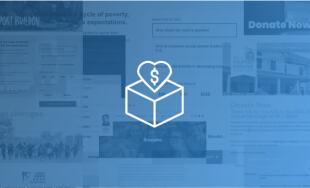A nonprofit's website serves a lot of purposes, ranging from educating people on the cause to engaging volunteers; however, few would argue that one of the most critical elements of a nonprofit site is to raise contributions from supporters. By the time someone has reached your donation page, they've likely already been worked up your organization's ladder of engagement and are ready to commit dollars to the cause.
The visitors who make it to the donation page don't need to be reeducated on the cause - by being on this page, they've already demonstrated they're supremely interested and motivated. This fact is important, because it means your donation page should focus on two important goals: ease of use and maximizing the donation amount. The people on this page have demonstrated a willingness to give, so make it easy for them and convince them to give a little more than planned.
This post explores how to make it easy for people to give and how to get the most from the donor.
Donation Page Optimization
When a visitor is on your donation page, you want to provide them an intuitive experience where they know exactly how to give and what they're giving to. The quickest way to lose credibility with a donor is have a donation page that confuses them or obscures the point of their action. Some tips to help you convert your visitors to donors:
- Have everything on a single page - In any web process, whether it's a donation, a signup, or just navigating a site, extra clicks lead to a higher abandonment rate. If you're forcing people to continue clicking, they will get fed up and decide not to act or they're in a rush and decide to "come back to it later," which typically doesn't ever happen. It's critical that everything, including the credit card fields, should be on a single page. When someone clicks "Submit" at the bottom of that page, everything should be set in motion and their job should be done.
- No login prompt - Similar to the idea of not forcing people to navigate multiple pages, you do not want to require or even strongly suggest that people login before they can donate. Many donors, even though they're engaging in a very serious act of support, are hesitant to give over more information or go through a cumbersome login process just to be able to hand you money. It's frustrating to all of us if someone won't just accept our money and requires us to jump through hoops. If there is a strong account-based element to your site, ask them to register after their donation or have a small link toward the top of the page that gives people the option to Create an Account. You want any registration to take a back seat to the actual donation.
- Equate each gift to a tangible item - While people are on this page, give them a quick reminder of what this donation is going to do. This step helps prevent any donor who gets to the page and starts to get cold feet; by reminding them of the good their dollar(s) will do, it will encourage them to follow through with the donation. This cue can be around the donation amounts or even at the top of the page and can be as simple as "Remember, each $5 you give, provides clean water for a family of 4 for 8 days." Simple and to the point, but it drives home the impact this donor will have by acting on this page.
- Clear errors and error tracking - It's a fact of life and of the web that things go wrong. It could be user error like mistyping a number, a system flaw like not accepting certain special characters, or a random event of the system going down. For whatever reason a donation doesn't go through, you want to provide a clear error report to the user and track that error in your system.
For example, "Error Class UHOH911!" isn't going to help anyone know what change to make for the donation go through, and as we've covered, people care about their time and you shouldn't be in the business of stealing it. A simple message like "Credit Card number entered not recognized" or even a friendly one like "Oops! It looks like that Credit Card number wasn't valid. It was probably just a typo, please try again" will tell people what is wrong and how to fix it. On your software's end, you'll want to track any errors so you can follow up with people who weren't able to give to not only apologize for the inconvenience but to try and get the donation over the phone or in the mail if it never went through.
These simple tactics that are standard in most online fundraising software helps the donor quickly and easily make a donation.
Donation Page Maximization
While the most important element of the donation page is accepting the actual donation and getting the money through, a close second is convincing people to give a little more than they originally planned. This strategy is typically overlooked by nonprofit teams, but the donation page represents an excellent opportunity to try and upsell donors on a bigger overall contribution. Here are some tips on how:
- Gifts at different donation levels - Having gifts in exchange for a donation is an all-around great idea. By giving people a tangible item in return for their money, they're more likely to give the gift, especially if that item carries a social value that signifies to others that the donor supports an important cause. In addition to giving gifts, staggering those gifts at different levels is an important way to convince people to give that extra $20 in order to get the gift they really want (we've previously shown how NPR's online fundraising strategy with gifts does a great job of pushing donors for more). By having gifts, you make it that much easier for someone who came to a site planning to give $5 to give $15 because they want something in return and if you have increasingly appealing gifts, your $50 donor may jump up to $100.
- Recurring donations - Not everyone is in the financial position or overall mindset to make a large gift when they land on a donation page. One way to ease them into being a bigger donor is by providing a recurring donation option at the bottom of the page. A successful conversion will turn a likely one-time $10 donor into an annual donor of $120 -- a 12x ROI for just having a checkbox on the page ain't too shabby. A lot of donors don't even realize this is an option, so make sure it's prominent and maybe even tie it into #1 and offer an additional gift for recurring supporters.
- Goal Graphic - One of the oldest strategies around is to show a visual goal on the donation page - it can be a thermometer, a bar graph, or something clever related to the campaign, but whatever it is, people want to help you hit that goal! The more detailed your graph is (e.g., showing $100 increments), the more likely it will be to impact someone's gift, as they'll want to help you over a visual hurdle and will be willing to give a little more to help you get there. The graphic spurs people to dig a little deeper to help you hit your goal.
- One more thing!! - Anyone getting ready to click the Submit button on your donation page has already cleared the mental hurdle of parting with their money to support your organization, so why not hit them with one more request for a donation? This tactic tends to be done with an "add-on" to the order like a ticket to an event, a tee shirt, a book about the organization, etc. The person has demonstrated they're a supporter, so give them one more way to support your mission before they leave the site and tie it to some sort of gift or offer that hasn't yet been presented.
These items will help you convince a donor to give a little more to support the organization and will help you build an even closer bond with them.
Every organization is different, but these are some of the valuable tips we've learned from working as a nonprofit web design firm and studying what works and what doesn't for our clients and others in the space. Some may not make sense for you or perhaps you don't have gifts to offer people, but I just encourage you to spend some time looking at your page as if you were a donor and figuring out what could be made easier for them and what would help them to decide to give a little more. If you come up with something other than what we've listed here, be sure to share it in the comments!
Update 6/23/20 – If you liked this post, check out Using Stripe and Wufoo for Nonprofit Donation Forms for instructions on how to implement a custom donation processor!





Leave the first comment